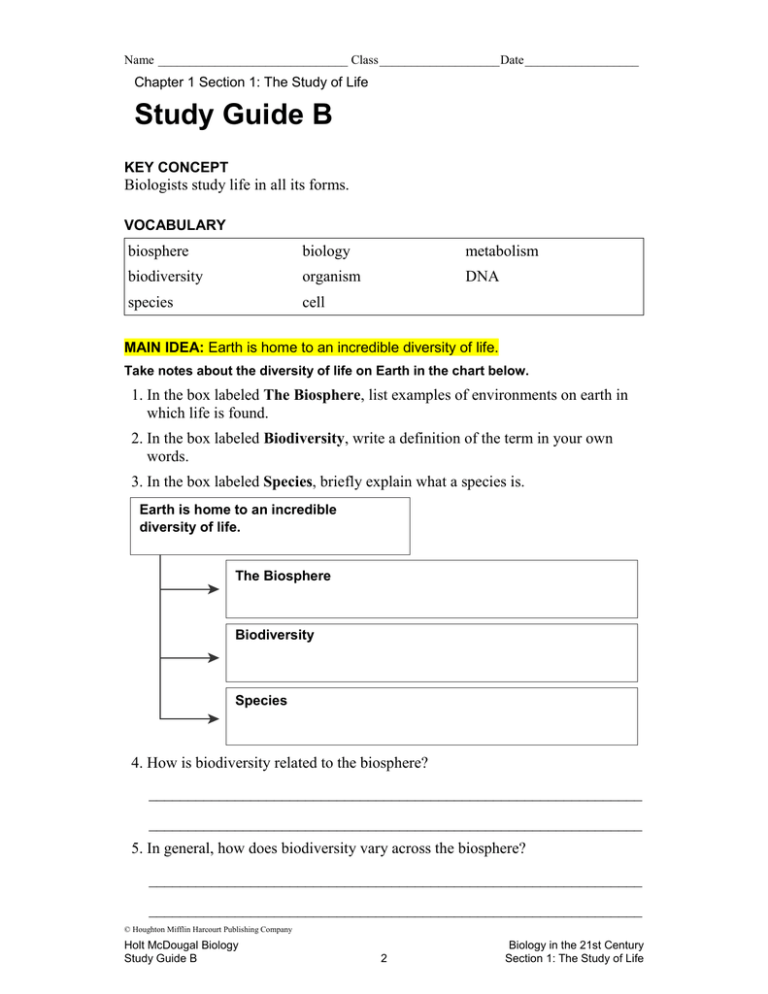Biology Study Guide: Life, Themes, and Science
advertisement

Name ______________________________ Class ___________________ Date __________________ Chapter 1 Section 1: The Study of Life Study Guide B KEY CONCEPT Biologists study life in all its forms. VOCABULARY biosphere biology metabolism biodiversity organism DNA species cell MAIN IDEA: Earth is home to an incredible diversity of life. Take notes about the diversity of life on Earth in the chart below. 1. In the box labeled The Biosphere, list examples of environments on earth in which life is found. 2. In the box labeled Biodiversity, write a definition of the term in your own words. 3. In the box labeled Species, briefly explain what a species is. Earth is home to an incredible diversity of life. The Biosphere Biodiversity Species 4. How is biodiversity related to the biosphere? _______________________________________________________________ _______________________________________________________________ 5. In general, how does biodiversity vary across the biosphere? _______________________________________________________________ _______________________________________________________________ © Houghton Mifflin Harcourt Publishing Company Holt McDougal Biology Study Guide B 2 Biology in the 21st Century Section 1: The Study of Life Name ______________________________ Class ___________________ Date __________________ Study Guide B continued MAIN IDEA: All organisms share certain characteristics. 6. Before reading, take a quick look at the headings in this main idea. What are the four characteristics that identify something as living? _______________________________________________________________ 7. As you read, take notes on how the four basic characteristics help define what is a living thing. Characteristic Summary Sentence Cells Energy and metabolism Response to environment Reproduction and development Vocabulary Check 8. The word biosphere is made up of two word parts: bio- and sphere. How can these two word parts help you to remember the definition of biosphere? _______________________________________________________________ _______________________________________________________________ _______________________________________________________________ 9. What is an organism? _______________________________________________________________ 10. The term metabolism is based on a Greek word that means “change.” How is this meaning related to the meaning of metabolism? _______________________________________________________________ 11. How is DNA related to reproduction? _______________________________________________________________ © Houghton Mifflin Harcourt Publishing Company Holt McDougal Biology Study Guide B 2 Biology in the 21st Century Section 1: The Study of Life Name ______________________________ Class ___________________ Date __________________ Chapter 1 Section 2: Unifying Themes of Biology Study Guide B KEY CONCEPT Unifying themes connect concepts from many fields of biology. VOCABULARY system homeostasis ecosystem evolution adaptation MAIN IDEA: All levels of life have systems of related parts. 1. What is a system? _______________________________________________________________ _______________________________________________________________ 2. What are some examples of systems? _______________________________________________________________ _______________________________________________________________ Complete the table by writing either the level of life or an example of a system at that level of life. Level Example 3. Chemicals and processes interact in a precise way so that a cell can function properly. Cells 4. 5. Different parts of a living thing work together so that the living thing can survive. Ecosystem 6. MAIN IDEA: Structure and function are related in biology. 7. What are structure and function? _______________________________________________________________ _______________________________________________________________ 8. Give an example of how structure and function are related on the cellular level. _______________________________________________________________ © Houghton Mifflin Harcourt Publishing Company Holt McDougal Biology Study Guide B 3 Biology in the 21st Century Section 2: Unifying Themes of Biology Name ______________________________ Class ___________________ Date __________________ Study Guide B continued MAIN IDEA: Organisms must maintain homeostasis to survive in diverse environments. 9. What is homeostasis? _______________________________________________________________ 10. Why is homeostasis important to the survival of an organism? _______________________________________________________________ _______________________________________________________________ 11. In the space below, draw a sketch to help you remember what negative feedback is. Body temperature decreases. Body systems send messages. MAIN IDEA: Evolution explains the unity and diversity of life. 12. What is evolution? _______________________________________________________________ 13. Over the course of time, evolution _______________ the genetic makeup of a population. 14. _____________ are genetic traits that give an advantage to an individual and can be passed on to offspring Vocabulary Check 15. A system in which living and nonliving things in a certain area interact is called a(n) _________________. 16. The maintenance of constant internal conditions in an organism is called _____________________. © Houghton Mifflin Harcourt Publishing Company Holt McDougal Biology Study Guide B 4 Biology in the 21st Century Section 2: Unifying Themes of Biology Name ______________________________ Class ___________________ Date __________________ Chapter 1 Section 3: Scientific Thinking and Processes Study Guide B KEY CONCEPT Science is a way of thinking, questioning, and gathering evidence. VOCABULARY observation hypothesis independent variable constant data experiment dependent variable theory MAIN IDEA: Like all science, biology is a process of inquiry. Complete the table below by giving a brief description and a brief example of each of the scientific process terms. Scientific Process Description Example Observation 1. 2. Data 3. 4. Hypothesis 5. 6. 7. How do scientists use statistics when they test a hypothesis? _______________________________________________________________ _______________________________________________________________ 8. Why is it important that a scientist’s results are evaluated by other scientists? _______________________________________________________________ _______________________________________________________________ 9. Look at Figure 3.3. Beginning with observation, what are five parts of scientific thinking? _______________________________________________________________ _______________________________________________________________ © Houghton Mifflin Harcourt Publishing Company Holt McDougal Biology Study Guide B 8 Chemistry of Life Section 1: Atoms, Ions, and Molecules Name ______________________________ Class ___________________ Date __________________ Study Guide B continued MAIN IDEA: Biologists use experiments to test hypotheses. 10. In _______________ studies, scientists do not interfere with what is going on. 11. Scientists can test hypotheses through ____________. 12. A(n) ____________ variable is one which is observed and not manipulated by the scientist. 13. How are constants different from independent variables? _______________________________________________________________ _______________________________________________________________ MAIN IDEA: A theory explains a wide range of observations. 14. What is the difference between a theory and a hypothesis? _______________________________________________________________ _______________________________________________________________ 15. Why are theories never proven? _______________________________________________________________ _______________________________________________________________ Vocabulary Check 16. What is a hypothesis? _______________________________________________________________ _______________________________________________________________ 17. How can you remember the difference between an independent variable and a dependent variable? Think about what the words independent and dependent mean. _______________________________________________________________ _______________________________________________________________ © Houghton Mifflin Harcourt Publishing Company Holt McDougal Biology Study Guide B 8 Chemistry of Life Section 1: Atoms, Ions, and Molecules Name ______________________________ Class ___________________ Date __________________ Chapter 2 Section 1: Atoms, Ions, and Molecules Study Guide B KEY CONCEPT All living things are based on atoms and their interactions. VOCABULARY atom ion molecule element ionic bond compound covalent bond MAIN IDEA: Living things consist of atoms of different elements. 1. How are atoms and elements related? _______________________________________________________________ 2. Sketch the structure of an atom. Label the protons, neutrons, nucleus, and electrons. 3. How do compounds differ from elements? _______________________________________________________________ MAIN IDEA: Ions form when atoms gain or lose electrons. 4. What is an ion? _______________________________________________________________ © Houghton Mifflin Harcourt Publishing Company Holt McDougal Biology Study Guide B 8 Chemistry of Life Section 1: Atoms, Ions, and Molecules Name ______________________________ Class ___________________ Date __________________ Study Guide B continued 5. Why does an ion have an electrical charge? _______________________________________________________________ _______________________________________________________________ 6. In the spaces provided below, sketch how both positive and negative ions form. Label the nucleus and the electrons. Use Figure 1.3 as a reference. MAIN IDEA: Atoms share pairs of electrons in covalent bonds. 7. What is a covalent bond? _______________________________________________________________ 8. What determines the number of covalent bonds that an atom can form? _______________________________________________________________ Vocabulary Check element compound ion molecule _______________ 9. atoms held together by covalent bonds _______________ 10. composed of different types of atoms _______________ 11. composed of one type of atom _______________ 12. atom that has gained or lost electrons 13. What is the difference between how ionic and covalent bonds form? _______________________________________________________________ _______________________________________________________________ © Houghton Mifflin Harcourt Publishing Company Holt McDougal Biology Study Guide B 8 Chemistry of Life Section 1: Atoms, Ions, and Molecules Name ______________________________ Class ___________________ Date __________________ Chapter 2 Section 2: Properties of Water Study Guide B KEY CONCEPT Water’s unique properties allow life to exist on Earth. VOCABULARY hydrogen bond solution acid cohesion solvent base adhesion solute pH MAIN IDEA: Life depends on hydrogen bonds in water. 1. What is a polar molecule? _______________________________________________________________ 2. Explain why water is a polar molecule. _______________________________________________________________ _______________________________________________________________ 3. What is a hydrogen bond? _______________________________________________________________ 4. Describe where a hydrogen bond can form among water molecules. _______________________________________________________________ Complete the table by writing short descriptions about the properties of water. Property Description High specific heat 5. Cohesion 6. Adhesion 7. © Houghton Mifflin Harcourt Publishing Company Holt McDougal Biology Study Guide B 10 Chemistry of Life Section 2: Properties of Water Name ______________________________ Class ___________________ Date __________________ Study Guide B continued MAIN IDEA: Many compounds dissolve in water. 8. What is the difference between a solvent and a solute? _______________________________________________________________ 9. What types of substances dissolve easily in water? _______________________________________________________________ 10. What types of substances do not dissolve easily in water? _______________________________________________________________ MAIN IDEA: Some compounds form acids or bases. 11. Take notes about the characteristics of acids and bases in the table below. Characteristic Acid Base Effect on H+ concentration in a solution Effect on pH Vocabulary Check 12. In the space below, sketch a solution using the Visual Vocab in Section 2 as a reference. Label the solution, solvent, and solute. Next to these labels, write brief definitions for the terms. © Houghton Mifflin Harcourt Publishing Company Holt McDougal Biology Study Guide B 10 Chemistry of Life Section 2: Properties of Water Name ______________________________ Class ___________________ Date __________________ Chapter 2 Section 3: Carbon-Based Molecules Study Guide B KEY CONCEPT Carbon-based molecules are the foundation of life. VOCABULARY monomer lipid amino acid polymer fatty acid nucleic acid carbohydrate protein MAIN IDEA: Carbon atoms have unique bonding properties. 1. Why is carbon often called the building block of life? _______________________________________________________________ _______________________________________________________________ 2. What ability allows carbon atoms to form a large number of molecules? _______________________________________________________________ _______________________________________________________________ 3. In the space below, sketch the three basic structures of carbon-based molecules: straight chain, branched chain, and ring. © Houghton Mifflin Harcourt Publishing Company Holt McDougal Biology Study Guide B 12 Chemistry of Life Section 5: Enzymes Name ______________________________ Class ___________________ Date __________________ Study Guide B continued MAIN IDEA: Four main types of carbon-based molecules are found in living things. Complete the table with functions and examples of each type of carbon-based molecule. Molecule Type Functions Examples Carbohydrate 4. 5. Lipid 6. 7. Protein 8. 9. 10. 11. Nucleic acid 12. What determines a protein’s structure and function? _______________________________________________________________ 13. What are nucleic acids made of? _______________________________________________________________ Vocabulary Check 14. The prefix mono- means “one,” and the prefix poly- means “many.” How are these meanings related to the terms monomer and polymer? _______________________________________________________________ _______________________________________________________________ _______________________________________________________________ © Houghton Mifflin Harcourt Publishing Company Holt McDougal Biology Study Guide B 12 Chemistry of Life Section 5: Enzymes





